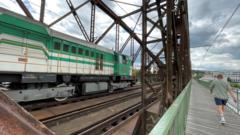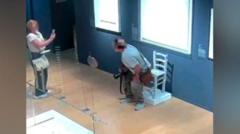The Vysehrad railway bridge, a storied 123-year-old landmark in Prague, has sparked passionate debate as plans emerge for its replacement. Known for its iconic arches set against the Vysehrad fortress, many believe the bridge is integral to the city’s architectural beauty. Architect Petr Tej states, “We need to preserve these panoramas," highlighting the bridge’s historical significance.
However, the Railway Authority argues that the bridge cannot withstand increasing rail traffic due to rust and damage. Pavel Paidar from the authority points out that the bridge currently limits capacity, while new plans include a modern bridge with an additional track, aiming to enhance rail services. The proposal to relocate the old bridge about 5 miles south remains controversial, with critics arguing that its new location does not suit its historical footprint.
Advocates for preservation, like the Vysehrad Bridge Foundation, argue that restoration is possible without major disruption and that most of the bridge is structurally sound, as backed by Unesco and a petition signed by over 25,000 residents. They propose a complementary bridge to meet transport needs while maintaining the original.
This dilemma raises fundamental questions about balancing modern progress with historical preservation, urging the Czech government to find a harmonious solution for both transport needs and cultural legacy in a city cherished for its architectural integrity.
However, the Railway Authority argues that the bridge cannot withstand increasing rail traffic due to rust and damage. Pavel Paidar from the authority points out that the bridge currently limits capacity, while new plans include a modern bridge with an additional track, aiming to enhance rail services. The proposal to relocate the old bridge about 5 miles south remains controversial, with critics arguing that its new location does not suit its historical footprint.
Advocates for preservation, like the Vysehrad Bridge Foundation, argue that restoration is possible without major disruption and that most of the bridge is structurally sound, as backed by Unesco and a petition signed by over 25,000 residents. They propose a complementary bridge to meet transport needs while maintaining the original.
This dilemma raises fundamental questions about balancing modern progress with historical preservation, urging the Czech government to find a harmonious solution for both transport needs and cultural legacy in a city cherished for its architectural integrity.





















